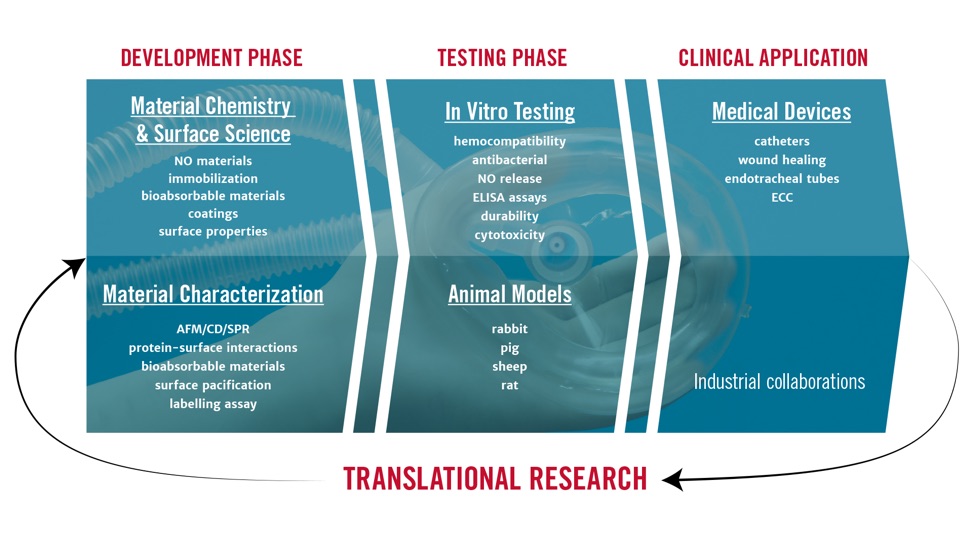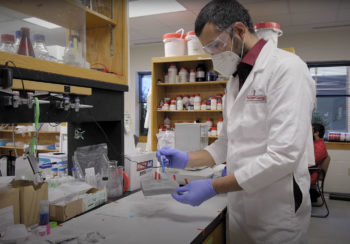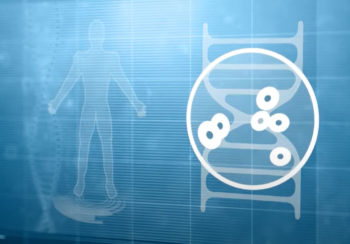Hitesh Handa doesn’t think a hospital stay for one problem should turn into another.
But that’s exactly what happens to tens of thousands of people every year when their central lines or catheters become infected during hospital stays.
Lucky for future hospital patients, Handa, an assistant professor of engineering at the University of Georgia, is developing coatings for medical devices to keep patients from contracting potentially deadly infections.
These coatings release nitric oxide, a powerful gas found naturally in the body that keeps blood flowing and staves off infection. It can also prevent bacteria from multiplying on the devices and causing disease.
“I feel engineers have a lot of solutions, but we don’t know what the problems are sometimes,” Handa says. “And clinicians have a lot of problems they want solutions for, but they don’t know who to go to. So, I thought, why not? I can be the bridge between engineers and clinicians.”

Handa’s background in polymer science, materials engineering and the medical device industry inform his commitment to practical research with tangible results. The nitric oxide coating technology has the potential to impact millions of patients, from those who are catheterized during hospital stays to those who undergo hemodialysis for kidney failure to those who need endotracheal tubes to breathe. “The impact can be huge,” Handa says.
Perhaps most exciting about Handa’s technology is that it employs a tool the body already uses for a similar purpose.
“Researchers around the world are trying to find solutions to blood clotting and infection, but I think what nature does is probably the best solution,” Handa says. “Why not mimic nature rather than designing our own ideas or materials or solutions to the problems?”

So that’s what Handa is doing, with supporting grants from both the Centers for Disease Control and Prevention and the National Institutes of Health. Preliminary data shows that the coated medical devices can prevent infection at a very high level, above 99 percent, in animal subjects.
The body recognizes medical devices, like catheters, stents and endotracheal tubes, as foreign entities that are invading, which prompts the blood to clot as a protective mechanism. Bacteria are also attracted to the surfaces of medical devices, bunching together to form what’s known as biofilm, a thick, difficult to penetrate layer of microorganisms. Large doses of antibiotics are needed to break through the blanket of bacteria. Nitric oxide, however, can address both of these issues.
“This nitric oxide coating technology has the potential to impact millions of patients.”
– Hitesh Handa, assistant professor of engineering
Plastic tubing with a nitric oxide coating can help “fool blood into believing it’s just another body part,” which would prevent clotting, Handa says. And nitric oxide’s small size makes it the perfect alternative to antibiotics to pass through biofilms to disperse bacteria.
An added bonus is that it’s difficult for bacteria to develop resistance to nitric oxide, an increasingly common problem with antibiotics.
Now Handa is focusing on how to translate his technology “from benchtop to bedside,” saying that, while publications are great, he wants to have a real impact on bettering people’s lives.
“We all have temporary time on Earth, right?” Handa says. “Why not do something that, when I’m dying, I think, ‘I did pretty well. I did something that can help people even when I’m gone.’”

About the Researcher
Hitesh Handa
Assistant Professor
School of Chemical, Materials and Biomedical Engineering
College of Engineering





